Well, the news is out -- the Apple iPad tablet has been revealed. There's a lot of instant reaction, but you'll have to wait some 3 months to actually buy the Wi-Fi version, and another month after that for the Wi-Fi + 3G version with AT&T cellular Internet data service.
As usual, the keynote presentation by Steve Jobs was masterly, and the introductory video carries on the theme of "Our most advanced technology in a magical and revolutionary device at an unbelievable price." Yeesh!
It's A Big iPod touch
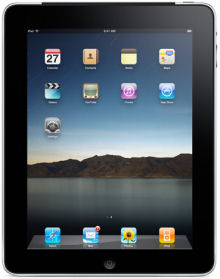 The iPad a beautiful device that seems to be quite smooth and responsive, with a 9.7 inch 1024 x 768 multi-touch display (vs. 3.5 inch 480 x 320 for the iPhone), though there is a rather wide bezel around the display.
The iPad a beautiful device that seems to be quite smooth and responsive, with a 9.7 inch 1024 x 768 multi-touch display (vs. 3.5 inch 480 x 320 for the iPhone), though there is a rather wide bezel around the display.
The size is a bit smaller than a pad of paper, at 7 1/2 x 9 1/2 x 1/2 inches, and 1 1/2 pounds. That's about the thickness of the iPhone, although a bit thicker then the iPod touch (at 1/3 inch).
The iPad is based on the iPhone software platform, and not a notebook platform like Mac OS. Jobs described it as "much more intimate than a laptop," so, for example, you still swipe the screen to unlock it.
And the iPad runs all the 140,000-some existing iPhone apps, in a small window at the center of the screen or pixel-doubled to fill the display. Apple also says you can sync your existing iPhone apps to the iPad, so you don’t have to buy them again.
It Runs Full-Screen Apps
Meanwhile, Apple has released developer tools to rework applications for the larger screen, and the iPad comes with 12 updated and new Apple apps that take advantage of the larger surface to view and interact with the multi-touch display. For example, the apps now use drop-down menus and pop-up context menus that don't really work on smaller displays. The resulting apps look more like laptop applications, from iPod music and Video browser / players, to Mail and Calendar and Contacts, to iTunes and App Stores -- plus the new iBookstore.
And Apple has developed versions of its iWork suite for the iPad - the Pages word processor, Numbers spreadsheet, and Keynote presentations, each for $9.99.
For text input, the iPad displays an almost-full-screen keyboard, although you'll need to work on finding a comfortable position to type comfortably with both hands, for example while resting the tablet in your lap.
The iPad line starts with a 16 GB model with Wi-Fi for $500. Add another $100 to double the memory, to 32 GB for $600, and then 64 GB for $700. The W-Fi + 3G models are then another $130 more, 16 GB for $630, 32 GB for $730, and the top of the line 64 GB with 3G for $830. AT&T 3G service will be $14.99 a month for 250 MB, or unlimited for $29.99 -- with no contract required.
It's Not a Netbook
Following the bigger iPod touch theme, the iPad is missing the same features that were stripped out of the iPhone to differentiate the touch, including the phone, camera, and GPS (except there's assisted GPS with the 3G model).
So the real question for the iPad is whether it's the right device to compete with all those $200 netbooks that flew off the shelves over the holidays (even stacked as impulse items in our local grocery stores).
Jobs was clear about his position -- "Netbooks aren’t better at anything -- They’re just like cheap laptops." And yes, what netbooks are better at is being cheap and highly portable.
But netbooks also give you a lot of options that the iPad does not, including a removable battery for long trips, and a memory card slot and USB connector to back up and exchange your work with others. And they have video connectors to display directly from your device, though VGA and even HDMI for HD video. With the iPad, these will require separate adapters for the Apple dock connector.
The iPad also appears to not have any new support for multitasking, which is interesting as Apple runs TV commercials promoting the iPhone's ability to run other apps as you talk on the phone. But you apparently still can't have apps running in the background checking for new information as you work or move around, and then notify you when needed. Yes, netbooks running Windows are slower than full-featured laptops as you switch between programs and run computer-intensive processing in the background, but at least you do have the option to work this way.
So the iPad is perhaps more comparable to the "quick-start" modes in some netbooks with products like Phoenix HyperSpace that lets you "use your PC like a smartphone." These are typically based on a slimmed down Linux OS that starts up instantly into a reduced environment for performing a wide range of common operations including playing media, editing documents, checking email, Web browsing (and playing videos), and even Internet phone.
When you limit the capabilities like this, netbooks can run quite well. Then you can switch to full Windows as needed for specific tasks, and accept the limitations of the underpowered platform if you choose to multi-task between more intensive processing.
It's A Merchandizing Channel
So it seems that the iPad is not a "netbook killer," at least for those who need the ability for a netbook to step up to heavier work. But the iPad certainly should be interesting to those who were looking at netbooks for only doing more basic viewing, editing, and browsing.
Plus, the familiarity of the iPhone interface and depth of the Apple's merchandising (iTunes, App, and now iBook store) are much more compelling than a generic netbook with a fast-start interface.
Perhaps the real bottom line of the iPod presentation was that Apple has seen over 12 billion downloads from its now three stores, and has assembled files of 125 million accounts with credit cards that can purchase from the stores. That's an amazingly powerful channel, and strong lock-in to its growing family of platforms.
See my Apple iPod / iPhone Gallery for details on the iPad, iPhone, and iPod products and product line history.
 Find the Apple iPad on Amazon.com
Find the Apple iPad on Amazon.com





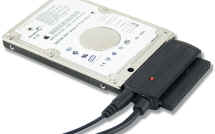
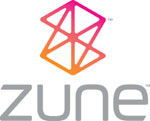

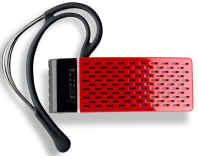 As noise-reducing headphones have become popular for listening to music, the same idea is now available for Bluetooth headsets, but with a new wrinkle -- the
As noise-reducing headphones have become popular for listening to music, the same idea is now available for Bluetooth headsets, but with a new wrinkle -- the 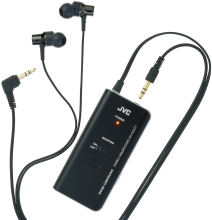 These are rated to cancel up to 80% of the background noise (more than 14dB at 120Hz), in combination with a tight seal from the earpieces. As a bonus, they work fine as headphones even when unpowered, and include a helpful Monitor switch to turn off audio playback so you can listen to important announcements.
These are rated to cancel up to 80% of the background noise (more than 14dB at 120Hz), in combination with a tight seal from the earpieces. As a bonus, they work fine as headphones even when unpowered, and include a helpful Monitor switch to turn off audio playback so you can listen to important announcements. The Archos 404 has a 3.5 in. screen and 30 GB for $299 with a stereo headphone mini-jack, and TV output jack, and supports voice recording. Archos also offers a model with an integrated camera.
The Archos 404 has a 3.5 in. screen and 30 GB for $299 with a stereo headphone mini-jack, and TV output jack, and supports voice recording. Archos also offers a model with an integrated camera. The obvious solution is a battery with the charger built in -- not to plug into the wall, but instead the
The obvious solution is a battery with the charger built in -- not to plug into the wall, but instead the  Findaway World of Cleveland, Ohio has a different idea that combines the best of both for convenient use: the
Findaway World of Cleveland, Ohio has a different idea that combines the best of both for convenient use: the  For this you need to pull out the heavy machinery, like the
For this you need to pull out the heavy machinery, like the 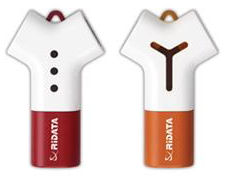 But if storage is good, then more storage is better, so why stop at a single USB drive? Instead, RiDATA offers multi-port designs like this Yego EZdrive so you can chain together multiple drives, or even use a drive as a hub to plug in additional drives.
But if storage is good, then more storage is better, so why stop at a single USB drive? Instead, RiDATA offers multi-port designs like this Yego EZdrive so you can chain together multiple drives, or even use a drive as a hub to plug in additional drives.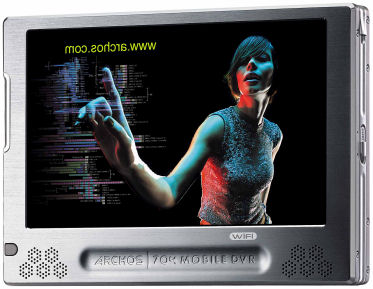
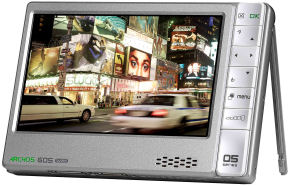 The new products look very familiar from the previous Gen 4 players, with the same metallic case design and user interface -- The focus here was on making them thinner and lighter and less expensive -- plus adding interesting upgrades like fun Widget applications and streaming Flash video over WiFi from sites including YouTube.
The new products look very familiar from the previous Gen 4 players, with the same metallic case design and user interface -- The focus here was on making them thinner and lighter and less expensive -- plus adding interesting upgrades like fun Widget applications and streaming Flash video over WiFi from sites including YouTube.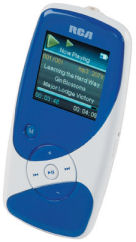 The RCA Opal is small and light -- just over 1 ounce, with a 1.5 inch color OLED screen, and plays music, and displays photos -- and plays video clips! It uses a built-in (not user swappable) lithium battery, with a rated music playback time of 15 hours.
The RCA Opal is small and light -- just over 1 ounce, with a 1.5 inch color OLED screen, and plays music, and displays photos -- and plays video clips! It uses a built-in (not user swappable) lithium battery, with a rated music playback time of 15 hours. If so, check out the
If so, check out the 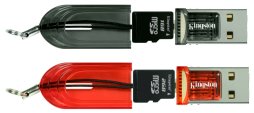
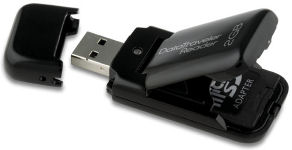 It reads SD, SDHC, MMC, and MMCplus cards, plus (with a separate adaptor, not included) miniSD, microSD, RS-MMC, MMCmobile, and MMCmicro.
It reads SD, SDHC, MMC, and MMCplus cards, plus (with a separate adaptor, not included) miniSD, microSD, RS-MMC, MMCmobile, and MMCmicro.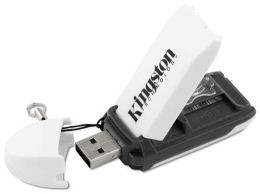 Side A reads SD, SDHC, MMC, MMCplus, RS-MMC, and MMCmobile. Side B has a slot for miniSD, and a second slot for microSD and MMCmicro (the reader appears in Windows as three drive letters).
Side A reads SD, SDHC, MMC, MMCplus, RS-MMC, and MMCmobile. Side B has a slot for miniSD, and a second slot for microSD and MMCmicro (the reader appears in Windows as three drive letters). The retractable USB connector is housed safely inside the casing. It's available with 1 GB for $19, 2 GB for $32, 4 GB for $59, and 8 GB for $116 (MSRP).
The retractable USB connector is housed safely inside the casing. It's available with 1 GB for $19, 2 GB for $32, 4 GB for $59, and 8 GB for $116 (MSRP). It brings along your own desktop's files, folders and icons, Outlook email contents, Internet Explorer settings, favorites, cookies and history. And it automatically synchronizes your data when you return to your PC. It's available with 1 GB for $20, 2 GB for $40, 4 GB for $75, and 8 GB for $154 (MSRP).
It brings along your own desktop's files, folders and icons, Outlook email contents, Internet Explorer settings, favorites, cookies and history. And it automatically synchronizes your data when you return to your PC. It's available with 1 GB for $20, 2 GB for $40, 4 GB for $75, and 8 GB for $154 (MSRP). Kingston just announced a new USB / microSD Mobility Kit, that combines its
Kingston just announced a new USB / microSD Mobility Kit, that combines its 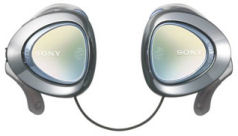 The Sony Stereo Bluetooth Headset DR-BT30Q is a minimalist design -- It has earpieces that clip on behind the ear, connected with a 20" retractable zip cord. It weighs about 2.1 oz., for $129.
The Sony Stereo Bluetooth Headset DR-BT30Q is a minimalist design -- It has earpieces that clip on behind the ear, connected with a 20" retractable zip cord. It weighs about 2.1 oz., for $129.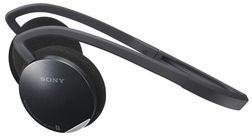 The Sony Stereo Bluetooth Headset DR-BT21G is a snazzy "street style" headset worn behind the head that hooks over the ears. It weighs about 2.3 oz., for $129. It folds up for storage.
The Sony Stereo Bluetooth Headset DR-BT21G is a snazzy "street style" headset worn behind the head that hooks over the ears. It weighs about 2.3 oz., for $129. It folds up for storage.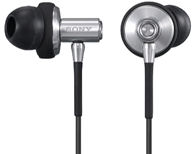 If you're looking high-end wired earphones, check out the Sony Stereo Earphones MDR-EX90LP with a metal housing. It includes 3 sizes of earbuds and a leather carrying case, for $100.
If you're looking high-end wired earphones, check out the Sony Stereo Earphones MDR-EX90LP with a metal housing. It includes 3 sizes of earbuds and a leather carrying case, for $100.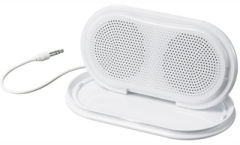 These pocket-size speakers even store flat; the protective speaker lid folds under as a speaker stand. They connect to players with a 12" straight stereo mini plug, weigh 7 oz., and are available in white or black for $24.99.
These pocket-size speakers even store flat; the protective speaker lid folds under as a speaker stand. They connect to players with a 12" straight stereo mini plug, weigh 7 oz., and are available in white or black for $24.99.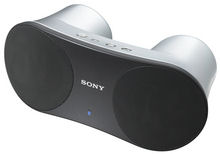 These lap-size speakers have a volume control, and are powered with AC adaptor or 3 AA batteries They're around 11 x 4 1/2 x 5 1/5 inches, weigh 1 lb. 10 oz., and are available for $149.99.
These lap-size speakers have a volume control, and are powered with AC adaptor or 3 AA batteries They're around 11 x 4 1/2 x 5 1/5 inches, weigh 1 lb. 10 oz., and are available for $149.99. The
The 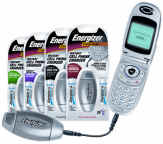
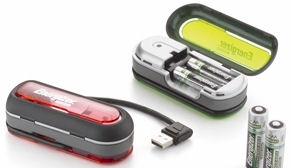 The
The  The
The  The
The  Another example is the newly updated
Another example is the newly updated 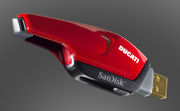 The new
The new 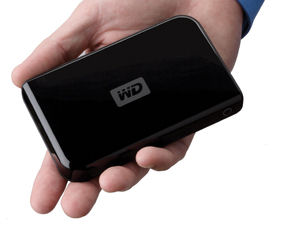
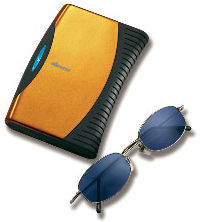 The Ultra TravelDrive includes two interchangeable color faceplates, and has rubberized anti-slip surfaces. It measures approximately 5 1/4 x 3 1/2 x 3/4 inches, and weighs 0.4 lbs. It's available from 80 GB for $99, 120 GB for $119, and 160 GB for $149.
The Ultra TravelDrive includes two interchangeable color faceplates, and has rubberized anti-slip surfaces. It measures approximately 5 1/4 x 3 1/2 x 3/4 inches, and weighs 0.4 lbs. It's available from 80 GB for $99, 120 GB for $119, and 160 GB for $149.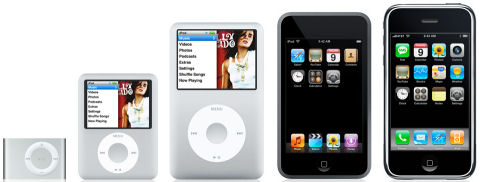
 Now SanDisk has retooled the product, and recently announced the redesigned
Now SanDisk has retooled the product, and recently announced the redesigned  The Solio chargers combine:
The Solio chargers combine: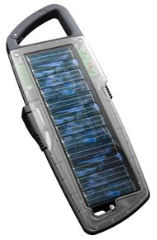 The Solio Classic ($99) unfolds with three panels, and includes a suction cup to attach to a window. The battery is 3.6 volts, 1600 mAh -- A fully charged unit is rated to recharge a typical mobile phone up to two times, or deliver up to 15 hours of MP3 music.
The Solio Classic ($99) unfolds with three panels, and includes a suction cup to attach to a window. The battery is 3.6 volts, 1600 mAh -- A fully charged unit is rated to recharge a typical mobile phone up to two times, or deliver up to 15 hours of MP3 music. For example, the Samsung YP-U3 is a stick music player with 2 GB for under $89. It's available in some uncommon pastel-ish colors, white, black, blue, green, and pink.
For example, the Samsung YP-U3 is a stick music player with 2 GB for under $89. It's available in some uncommon pastel-ish colors, white, black, blue, green, and pink.  The Samsung YP-K3 has a similar design sense, as a slim and elegant player with 2 GB for $119, and 4 GB for under $169. The player is framed in silver around the edges, with the rich colors on front and back: black, red, and green.
The Samsung YP-K3 has a similar design sense, as a slim and elegant player with 2 GB for $119, and 4 GB for under $169. The player is framed in silver around the edges, with the rich colors on front and back: black, red, and green. The
The 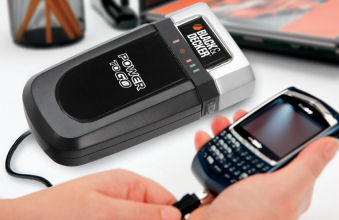 For more power, try the line of
For more power, try the line of  The Inflight Power Cable converts the audio signal into USB power, so it works with devices including cell phones, smart phones, music players, and game players using existing USB charging cables.
The Inflight Power Cable converts the audio signal into USB power, so it works with devices including cell phones, smart phones, music players, and game players using existing USB charging cables. 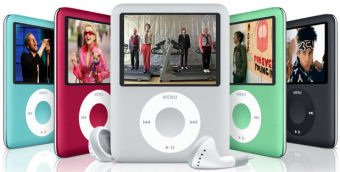

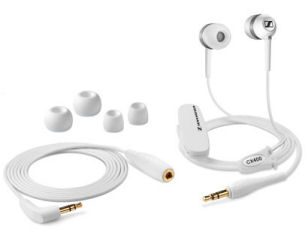 - The Classic CX 400 features shallow ear canal adapters for wearing comfort and passive noise attenuation, and include three ear fit adapters (S/M/L), for $99. It has a short cable that's great for use with a player in the pocket or on an armband, or when used with a remote control or microphone.
- The Classic CX 400 features shallow ear canal adapters for wearing comfort and passive noise attenuation, and include three ear fit adapters (S/M/L), for $99. It has a short cable that's great for use with a player in the pocket or on an armband, or when used with a remote control or microphone.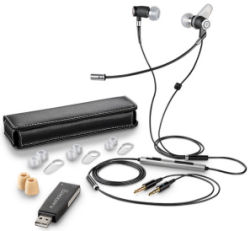 But the new idea is the
But the new idea is the 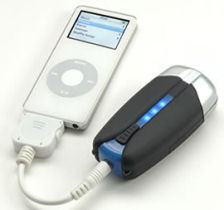 And that's what
And that's what 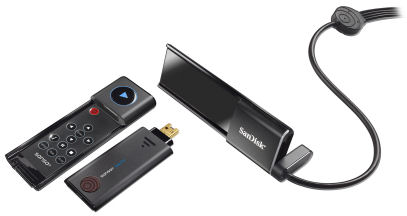
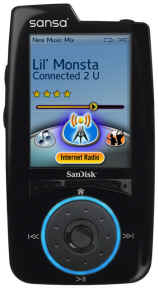
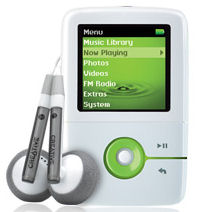
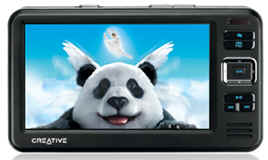 The Creative ZEN Vision has a 3.7 inch display at 8.4 ounces, and the Creative ZEN Vision W has a 4.3 inch widescreen display, with 30 GB $279, 60 GB $399.
The Creative ZEN Vision has a 3.7 inch display at 8.4 ounces, and the Creative ZEN Vision W has a 4.3 inch widescreen display, with 30 GB $279, 60 GB $399. 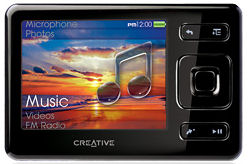 The ZEN front is sized like a credit card with a 2.5 inch screen, at 2.2 x 3.3 x 0.44 inches, and 2.3 ounces. It's available with 4 GB for $129, 8 GB for $199, and 16 GB for $249.
The ZEN front is sized like a credit card with a 2.5 inch screen, at 2.2 x 3.3 x 0.44 inches, and 2.3 ounces. It's available with 4 GB for $129, 8 GB for $199, and 16 GB for $249.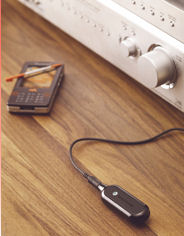 The
The 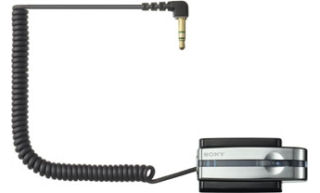 The Sony TMR-BT10 Bluetooth transmitter module sends stereo audio from a digital music player to a Bluetooth-equipped headset, speaker system or car stereo ($79 / $53).
The Sony TMR-BT10 Bluetooth transmitter module sends stereo audio from a digital music player to a Bluetooth-equipped headset, speaker system or car stereo ($79 / $53). The Sony HWS-BTA2W Bluetooth transmitter/receiver is dual-use ($79). As a transmitter, it streams stereo audio from devices with standard stereo mini plugs, such as cell phones with adapters, MP3 players, PCs, and home stereo systems. As a receiver, it converts almost any speaker system into a stereo Bluetooth speaker from the line out jack.
The Sony HWS-BTA2W Bluetooth transmitter/receiver is dual-use ($79). As a transmitter, it streams stereo audio from devices with standard stereo mini plugs, such as cell phones with adapters, MP3 players, PCs, and home stereo systems. As a receiver, it converts almost any speaker system into a stereo Bluetooth speaker from the line out jack.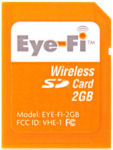 Your problems are solved, with the Eye-Fi Wi-Fi-enabled SD memory card ($99 for 2 GB). Just configure it on your PC or Mac to connect to your home network, and then plug it into your camera. Then whenever you store images on the card, and it's in range of your network, it will transfer the photos to a folder on your computer.
Your problems are solved, with the Eye-Fi Wi-Fi-enabled SD memory card ($99 for 2 GB). Just configure it on your PC or Mac to connect to your home network, and then plug it into your camera. Then whenever you store images on the card, and it's in range of your network, it will transfer the photos to a folder on your computer. 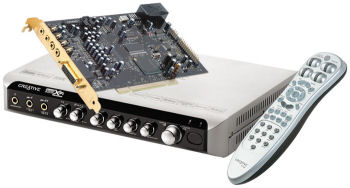 - High-performance surround-sound boards to deliver blow-out entertainment and gaming, with build-in sound mixing and enhancement.
- High-performance surround-sound boards to deliver blow-out entertainment and gaming, with build-in sound mixing and enhancement.
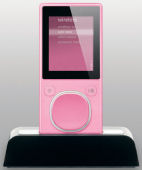 Plus, the line adds two models with flash memory, the Zune 4 and 8 GB ($149 and $199), available in pink, green, black, and glossy red. The screens are 1.8", but still 320 x 240, and they weigh 1.7 oz.
Plus, the line adds two models with flash memory, the Zune 4 and 8 GB ($149 and $199), available in pink, green, black, and glossy red. The screens are 1.8", but still 320 x 240, and they weigh 1.7 oz.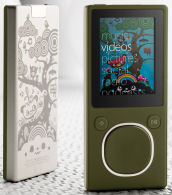
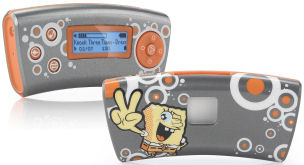 - The simple Fission Digital Music Player for $49 has an easy-to hold design with a slight curve, at 3.6 x 0.7 x 1.7 inches. It plays MP3 and WMA formats, including protected WMA files.
- The simple Fission Digital Music Player for $49 has an easy-to hold design with a slight curve, at 3.6 x 0.7 x 1.7 inches. It plays MP3 and WMA formats, including protected WMA files. 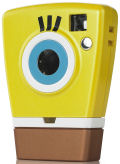 - The compact SpongeBob SquarePants Flash Micro Digital Camera for $19 features a striking yellow SpongeBob eyeball design, has a small LCD used for a few digits of status information, plus a built-in USB connector on the bottom.
- The compact SpongeBob SquarePants Flash Micro Digital Camera for $19 features a striking yellow SpongeBob eyeball design, has a small LCD used for a few digits of status information, plus a built-in USB connector on the bottom. 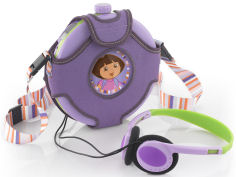
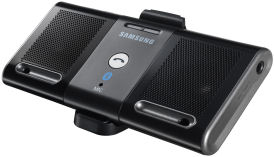 The new
The new 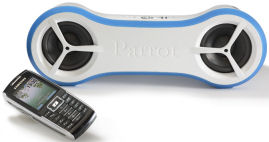 But for less controlled enviroments, you can step up the
But for less controlled enviroments, you can step up the 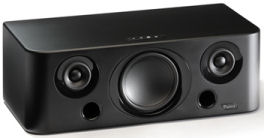 -
- 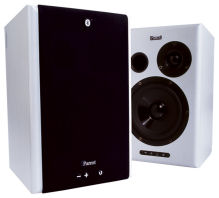 -
-  -
- 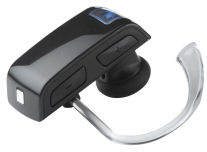 For example, the
For example, the  Which is the idea behind the
Which is the idea behind the 

 And now for something different in earphones -- the
And now for something different in earphones -- the  The
The  So here's an iconic design that satisfies these constraints, the
So here's an iconic design that satisfies these constraints, the 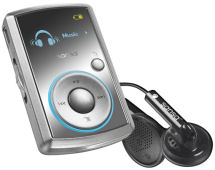 If you like the idea of a tiny music player that's easy to carry, then check out the
If you like the idea of a tiny music player that's easy to carry, then check out the 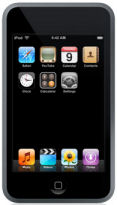 More memory for portable media players --
More memory for portable media players -- 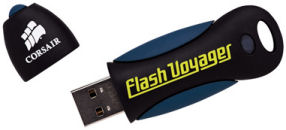 The durable
The durable  The rugged
The rugged  The
The 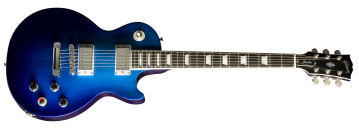
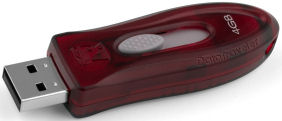 The new budget
The new budget 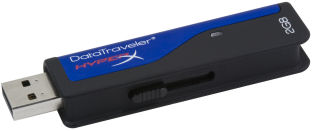 For faster data transfer, the new ultrafast
For faster data transfer, the new ultrafast 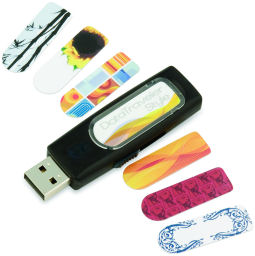 Or to keep track of your data, the new
Or to keep track of your data, the new  The small
The small  The spiffy
The spiffy  The
The  The
The 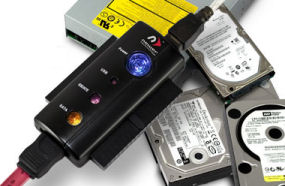 The
The  The
The 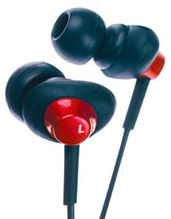 The
The 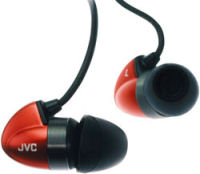 The high-end
The high-end 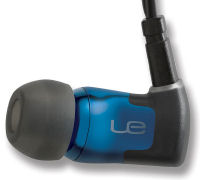 We tried out the
We tried out the  The
The 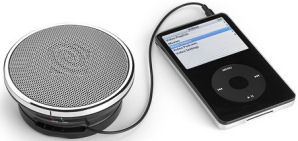 Portable speakers like the
Portable speakers like the 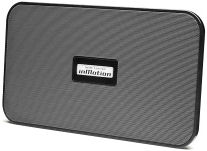
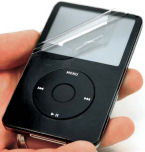 invisibleSHIELD is a clear, thin adhesive film that provides tough and durable scratch protection for a wide variety of gadgets. The film is a clear urethane plastic, with self-healing and abrasion resistance properties. It's based on a material used to protect the leading edges of helicopter blades in the U.S. military.
invisibleSHIELD is a clear, thin adhesive film that provides tough and durable scratch protection for a wide variety of gadgets. The film is a clear urethane plastic, with self-healing and abrasion resistance properties. It's based on a material used to protect the leading edges of helicopter blades in the U.S. military.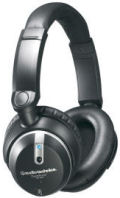 Coming from a name like Audio-Technica, with its background in high-performance audio for home and professional use, we had high expectations for the
Coming from a name like Audio-Technica, with its background in high-performance audio for home and professional use, we had high expectations for the 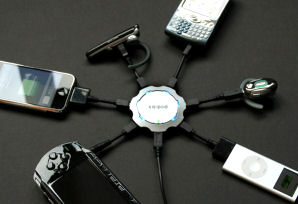 But if you have a bunch of handled devices, check out the
But if you have a bunch of handled devices, check out the 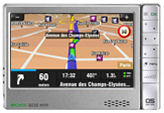 In-car windshield holder with GPS antenna. Software provides full-fledged navigation system with TeleAtlas maps. (Available 4/08 - $129 stand-alone, or $399 bundled with 30 GB ARCHOS 605 WiFi player)
In-car windshield holder with GPS antenna. Software provides full-fledged navigation system with TeleAtlas maps. (Available 4/08 - $129 stand-alone, or $399 bundled with 30 GB ARCHOS 605 WiFi player)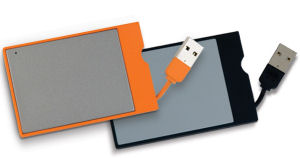 Credit card:
Credit card: 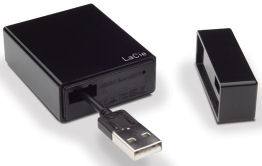 Match box:
Match box:  Cigarette case:
Cigarette case: 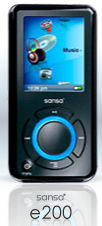


 The Zune video store is expanding to include downloads of more than 800 episodes of popular television shows that can be downloaded and synced to a Zune device.
The Zune video store is expanding to include downloads of more than 800 episodes of popular television shows that can be downloaded and synced to a Zune device. The
The 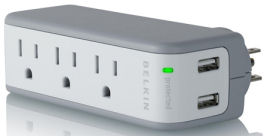 And for powering multiple devices, the
And for powering multiple devices, the 
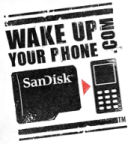 SanDisk has been promoting the use of microSD flash memory cards in its
SanDisk has been promoting the use of microSD flash memory cards in its 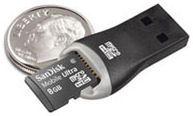 SanDisk recently announced
SanDisk recently announced  So check out
So check out 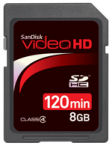 So it's not surprising that
So it's not surprising that 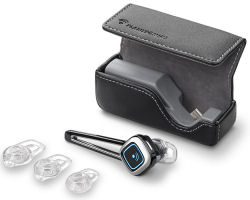 The new
The new  At the minimalist end, the
At the minimalist end, the 

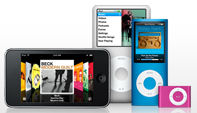 It's September -- and time for the annual refresh of the
It's September -- and time for the annual refresh of the  - The new
- The new 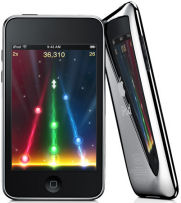 - The new
- The new 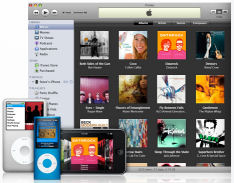 -
- 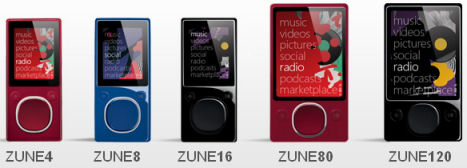
 The iCarly Micro MP3 Digital Music Player is small and simple (like the iPod shuffle), and stores some 250 songs (in 1 GB). It comes preloaded with a sample of iCarly’s new single, “Leave it All to Me!” ($29.99 at
The iCarly Micro MP3 Digital Music Player is small and simple (like the iPod shuffle), and stores some 250 songs (in 1 GB). It comes preloaded with a sample of iCarly’s new single, “Leave it All to Me!” ($29.99 at  The iCarly Travel Speaker Case is a zippered case with shoulder strap, with a nook for a MP3 player on one side and built-in speakers on the other. Plug in the line-in jack to play your music out load, or use the dual headphone jacks to listen with friend.
The iCarly Travel Speaker Case is a zippered case with shoulder strap, with a nook for a MP3 player on one side and built-in speakers on the other. Plug in the line-in jack to play your music out load, or use the dual headphone jacks to listen with friend.  The SpongeBob SquarePants Eyeball Speaker Dock is a wacky yellow sponge speaker. Nest your MP3 player in the cradle on top, wire up line-in to the player and left/right audio to the two eyeball speakers. And the speakers are removable -- select ROCK mode to have them wobble, rock and roll with the music (as a motor runs inside). ($39.99 at
The SpongeBob SquarePants Eyeball Speaker Dock is a wacky yellow sponge speaker. Nest your MP3 player in the cradle on top, wire up line-in to the player and left/right audio to the two eyeball speakers. And the speakers are removable -- select ROCK mode to have them wobble, rock and roll with the music (as a motor runs inside). ($39.99 at  The SpongeBob SquarePants Digital Photo Viewer is a small and simple way to share photos, as the cover flips around as a stand to show the tiny 1.4" display. It stores up to 59 photos (in 2 MB), but requiring the built-in ImageViewer software to transfer files (Windows).
The SpongeBob SquarePants Digital Photo Viewer is a small and simple way to share photos, as the cover flips around as a stand to show the tiny 1.4" display. It stores up to 59 photos (in 2 MB), but requiring the built-in ImageViewer software to transfer files (Windows).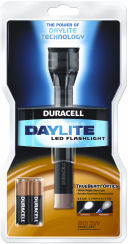 I'm a big fan of LED flashlights -- they're rugged and last forever, and quite bright. But now my flashlights pale by comparison to the new
I'm a big fan of LED flashlights -- they're rugged and last forever, and quite bright. But now my flashlights pale by comparison to the new  Combining "fashion-conscious style and audio-enthusiast sound," the
Combining "fashion-conscious style and audio-enthusiast sound," the  Or, you can get earphones that let you customize the sound of music, like the
Or, you can get earphones that let you customize the sound of music, like the 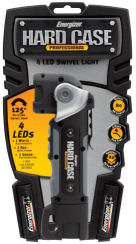 For example, the Energizer Hard Case Professional 2AA Swivel Light features a rotating swivel head (125 degrees) and a choice of lights: the main high intensity white LED, two red LEDs for night vision, and a green LED for pipe inspection.
For example, the Energizer Hard Case Professional 2AA Swivel Light features a rotating swivel head (125 degrees) and a choice of lights: the main high intensity white LED, two red LEDs for night vision, and a green LED for pipe inspection. So maybe there's still a place for a new physical purchased music format -- the
So maybe there's still a place for a new physical purchased music format -- the 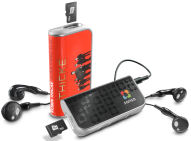 SanDisk also has released an accompanying dead simple player device -- the
SanDisk also has released an accompanying dead simple player device -- the 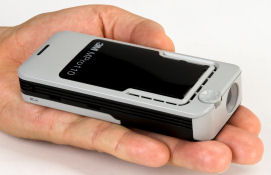 The new
The new 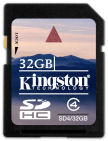
 Meanwhile, the ridiculously small microSD cards, designed for use in tiny mobile phones, are only a step behind. The SanDisk 16 GB microSDHC card lists at $99, with 8 GB for $49, 4 GB for $29, and 2 GB for $19.
Meanwhile, the ridiculously small microSD cards, designed for use in tiny mobile phones, are only a step behind. The SanDisk 16 GB microSDHC card lists at $99, with 8 GB for $49, 4 GB for $29, and 2 GB for $19. The
The 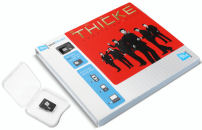 For example, the slotMusic version of the Robert Thicke album, Someting Else, has a Music folder with the 12 MP3 tracks, plus bonus material: an Extras folder with a few photos of Thicke and a Video folder with three music clips and an interview. And all that uses 530 MB, so almost half the capacity of the card is still available.
For example, the slotMusic version of the Robert Thicke album, Someting Else, has a Music folder with the 12 MP3 tracks, plus bonus material: an Extras folder with a few photos of Thicke and a Video folder with three music clips and an interview. And all that uses 530 MB, so almost half the capacity of the card is still available. Sometimes it's just simple things that make sense, like the
Sometimes it's just simple things that make sense, like the  Having fun with your new gaming systems? Those wireless controllers are fun, but can eat up batteries, especially for enthusiastic gamers.
Having fun with your new gaming systems? Those wireless controllers are fun, but can eat up batteries, especially for enthusiastic gamers. The
The  Meanwhile, Sony has worked with SanDisk to also bump up the capacity of its
Meanwhile, Sony has worked with SanDisk to also bump up the capacity of its  Instead, the
Instead, the  Or you can use
Or you can use 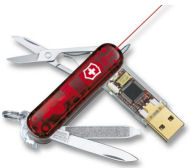 The full line of Swiss Army pocket multi-tools, shown at CES, includes LED flashlights,
The full line of Swiss Army pocket multi-tools, shown at CES, includes LED flashlights,  The
The  You can protect your devices with a layer of protective plastic (see
You can protect your devices with a layer of protective plastic (see 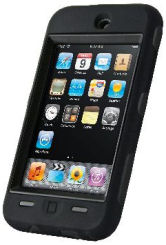 The
The 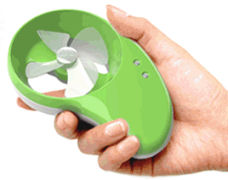 Then there's the
Then there's the 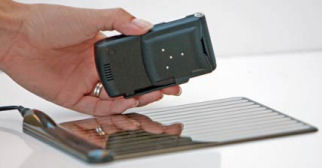 The
The  The
The 
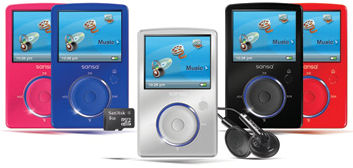
 The
The 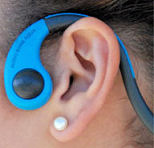 And now there's another approach --
And now there's another approach --  The
The  The
The 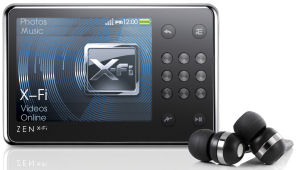 The
The  But once radio becomes a stream of music, independent from the source and the playback device, it does not even need to be streaming live -- you could also store it locally and play through it later. This is the idea behind the
But once radio becomes a stream of music, independent from the source and the playback device, it does not even need to be streaming live -- you could also store it locally and play through it later. This is the idea behind the 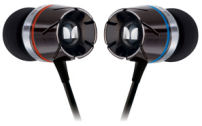 The
The  The original Apple iPod shuffle from 2005 was the exemplar of the "pack of gun" form factor (3.3 x 0.98 x 0.33 in., 0.78 oz.).
The original Apple iPod shuffle from 2005 was the exemplar of the "pack of gun" form factor (3.3 x 0.98 x 0.33 in., 0.78 oz.). 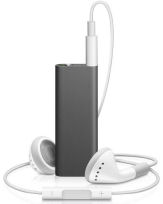 So today Apple announced its solution with the
So today Apple announced its solution with the  But
But  Or if you're not the key ring type, you can carry your data along with your loose change with the
Or if you're not the key ring type, you can carry your data along with your loose change with the 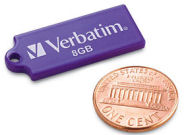 Just when you thought USB drives couldn't get any smaller, new technology comes to the rescue with the
Just when you thought USB drives couldn't get any smaller, new technology comes to the rescue with the 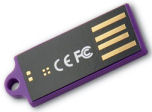 But how do you use a device that literally half the width of a USB port? Just insert the drive with the contacts facing the USB logo, or to the center of the connector. Or just try to shove it in -- you'll notice that it does not fit right if you have it backwards.
But how do you use a device that literally half the width of a USB port? Just insert the drive with the contacts facing the USB logo, or to the center of the connector. Or just try to shove it in -- you'll notice that it does not fit right if you have it backwards. The first news was from
The first news was from  Companies like
Companies like 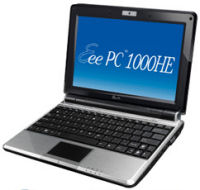 For example, the
For example, the  Wuala really is a diffuse cloud -- It encrypts your shared files, splits them into fragments, and then stores them redundantly on servers and in its grid network. There's a desktop client for Windows, Mac, and Linux to drag-and-drop files to upload in the background, with fast download though parallel peer-to-peer connections.
Wuala really is a diffuse cloud -- It encrypts your shared files, splits them into fragments, and then stores them redundantly on servers and in its grid network. There's a desktop client for Windows, Mac, and Linux to drag-and-drop files to upload in the background, with fast download though parallel peer-to-peer connections. For example, the
For example, the 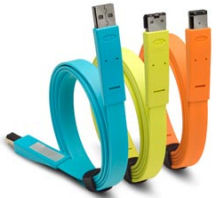 And the
And the 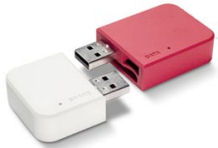 And now there's the
And now there's the  These are stylish speakers for PC or Mac that conveniently plug in to your computer's USB port and just work. They're plug and play, with no additional drivers needed. And they're powered over the USB connection, so no additional AC adapter or batteries are required.
These are stylish speakers for PC or Mac that conveniently plug in to your computer's USB port and just work. They're plug and play, with no additional drivers needed. And they're powered over the USB connection, so no additional AC adapter or batteries are required. Netbook computers are coming along fast as a viable alternative to traditional notebooks -- significantly smaller, lighter, and less expensive (around 2 to 3 pounds, $300 to $500). Yes, they're underpowered and have less capacity, but they work fine for keeping in touch with e-mail and Web browsing, and for basic office tasks. (Photo: Verizon / HP Mini compared to a traditional notebook)
Netbook computers are coming along fast as a viable alternative to traditional notebooks -- significantly smaller, lighter, and less expensive (around 2 to 3 pounds, $300 to $500). Yes, they're underpowered and have less capacity, but they work fine for keeping in touch with e-mail and Web browsing, and for basic office tasks. (Photo: Verizon / HP Mini compared to a traditional notebook) This week, for example,
This week, for example,  The new Dell Inspiron Mini 10v also has a 10-inch display, but starts at 2.5 pounds and $299. [Photo courtesy of Dell Inc.]
The new Dell Inspiron Mini 10v also has a 10-inch display, but starts at 2.5 pounds and $299. [Photo courtesy of Dell Inc.]
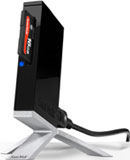 The smaller SanDisk ImageMate Multi-Card USB Reader/Writer is only some 2 1/4 x 1 1/2 x 3/8 inches. The trick to making it so small is that it has only one card slot, which can handle the basic variants of all four main memory card formats (SD / MMC, Memory Stick, and xD) -- though not the micro sizes or Compact Flash. It's rated to support up to 30 MB/sec. read and 27 MB/sec. write speeds with a SanDisk Extreme III 30 MB/Sec. SDHC card. Zoom!
The smaller SanDisk ImageMate Multi-Card USB Reader/Writer is only some 2 1/4 x 1 1/2 x 3/8 inches. The trick to making it so small is that it has only one card slot, which can handle the basic variants of all four main memory card formats (SD / MMC, Memory Stick, and xD) -- though not the micro sizes or Compact Flash. It's rated to support up to 30 MB/sec. read and 27 MB/sec. write speeds with a SanDisk Extreme III 30 MB/Sec. SDHC card. Zoom! The sibling SanDisk ImageMate All-In-One USB Reader/Writer is about twice as long, to fit the more traditional four card slots (for microSD, SD/MMC, Memory Stick / Duo, and CF variants). And it's rated to support up to 34 MB/sec. with a SanDisk Extreme IV 45 MB/sec. CompactFlash card.
The sibling SanDisk ImageMate All-In-One USB Reader/Writer is about twice as long, to fit the more traditional four card slots (for microSD, SD/MMC, Memory Stick / Duo, and CF variants). And it's rated to support up to 34 MB/sec. with a SanDisk Extreme IV 45 MB/sec. CompactFlash card. 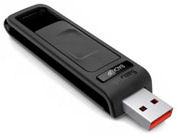 The
The 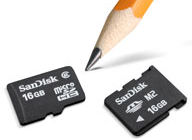 One clear example of shrinking to the edge of usability is the
One clear example of shrinking to the edge of usability is the  But now even the USB card readers are getting amazingly miniaturized. The previous
But now even the USB card readers are getting amazingly miniaturized. The previous 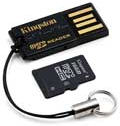 The updated
The updated 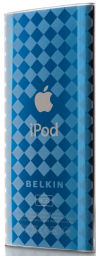 So check out the
So check out the  But you can turn your portable device into an entertainment system with a portable speaker like the
But you can turn your portable device into an entertainment system with a portable speaker like the  One answer is to use sound-isolating earphones, with a tight fit in the ear to reduce the outside noise so you can lower the volume from your music player. An even better answer for children and people with sensitive hearing is earphones like the
One answer is to use sound-isolating earphones, with a tight fit in the ear to reduce the outside noise so you can lower the volume from your music player. An even better answer for children and people with sensitive hearing is earphones like the 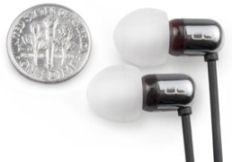 The SuperFi line still provides pro-quality sound for serious music lovers, but at around half the price. The new
The SuperFi line still provides pro-quality sound for serious music lovers, but at around half the price. The new  We tried out the
We tried out the 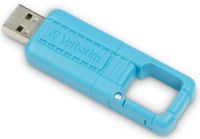 Now there's the
Now there's the 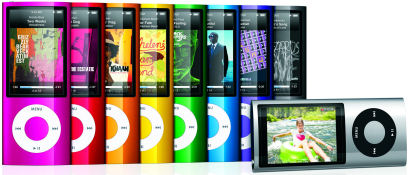
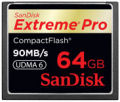 For example, SanDisk has just refreshed its line of CompactFlash cards, featuring the
For example, SanDisk has just refreshed its line of CompactFlash cards, featuring the 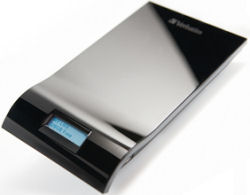 Products like the new
Products like the new 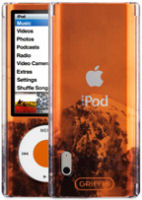 So
So  Instead, you can pack portable sound like the new
Instead, you can pack portable sound like the new  The new Jawbone Prime is the latest generation in the line, with even better noise elimination, especially in reducing the effect of wind noise (see
The new Jawbone Prime is the latest generation in the line, with even better noise elimination, especially in reducing the effect of wind noise (see  Compared to the
Compared to the  The
The 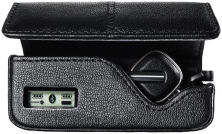 Beyond the looks, the clever element of the Discovery 975 is the included charging carrying case. This is a small padded case that includes a rechargeable battery, so you can dock the headset to recharge, tripling the headset talk time when on the road.
Beyond the looks, the clever element of the Discovery 975 is the included charging carrying case. This is a small padded case that includes a rechargeable battery, so you can dock the headset to recharge, tripling the headset talk time when on the road.  Compared to some other sexy designs, the
Compared to some other sexy designs, the  One alternative is to carry one power supply with a system of interchangeable tips for powering your various devices. Even better, you can carry a separate rechargeable battery like the
One alternative is to carry one power supply with a system of interchangeable tips for powering your various devices. Even better, you can carry a separate rechargeable battery like the 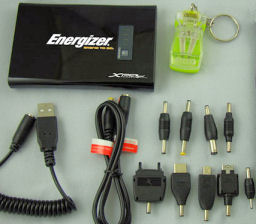

 If you want to customize your iPhone -- or other mobile phone -- with distinctive ringtones, then Sony Creative Software has a disc for you -- the
If you want to customize your iPhone -- or other mobile phone -- with distinctive ringtones, then Sony Creative Software has a disc for you -- the  The
The 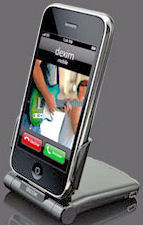 The new
The new  And to share your photos and videos on TV, the
And to share your photos and videos on TV, the  The
The 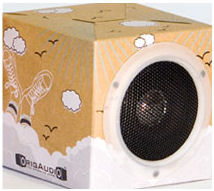 The new
The new 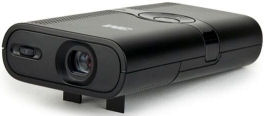 What you need, then, is your own pocket-size projector like the second-generation
What you need, then, is your own pocket-size projector like the second-generation  So, for example, you can leverage the converged and connected smartphone platform by first removing the phone part of a smartphone, and keeping the connectivity (though Wi-Fi) and the apps -- as in the Apple iPod touch. But then take another step to enlarge the screen a bit, to more like 5 inches, and you get a much improved viewing experience in a device that is still pocketable -- like the recently released
So, for example, you can leverage the converged and connected smartphone platform by first removing the phone part of a smartphone, and keeping the connectivity (though Wi-Fi) and the apps -- as in the Apple iPod touch. But then take another step to enlarge the screen a bit, to more like 5 inches, and you get a much improved viewing experience in a device that is still pocketable -- like the recently released 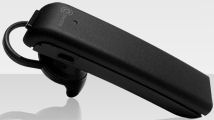 The design of the Sound ID 400 Headset is very clean -- slim and light (under (0.28 ounces).
The design of the Sound ID 400 Headset is very clean -- slim and light (under (0.28 ounces).  The separate Sound ID Remote Microphone is the same size and shape, but designed as a clip-on device to boost the sound during a conversation, or from a sound source across the room. The Bluetooth connection works up to 30 feet line of sight, or less though ceilings and walls.
The separate Sound ID Remote Microphone is the same size and shape, but designed as a clip-on device to boost the sound during a conversation, or from a sound source across the room. The Bluetooth connection works up to 30 feet line of sight, or less though ceilings and walls. In comparison to the low-profile design of the Sound ID 400 (see
In comparison to the low-profile design of the Sound ID 400 (see 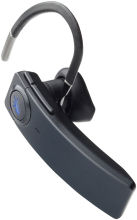 The BlueAnt Q1 Bluetooth headset is voice controlled -- It provides voice prompts instead of beeps for feedback -- and responds to over 20 spoken commands. When you receive a call, the Q1 reads the number to you, and then asks for your command to "Answer" or "Ignore" the call.
The BlueAnt Q1 Bluetooth headset is voice controlled -- It provides voice prompts instead of beeps for feedback -- and responds to over 20 spoken commands. When you receive a call, the Q1 reads the number to you, and then asks for your command to "Answer" or "Ignore" the call. 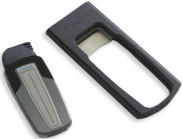 - MoGo Talk for VOIP & Skype ($99) snaps into a small Express Card 34 charging adapter, to store and charge in your notebook's Express Card 34 or Express Card 54 slot.
- MoGo Talk for VOIP & Skype ($99) snaps into a small Express Card 34 charging adapter, to store and charge in your notebook's Express Card 34 or Express Card 54 slot.  The dual-screen
The dual-screen  The new
The new  For example,
For example, 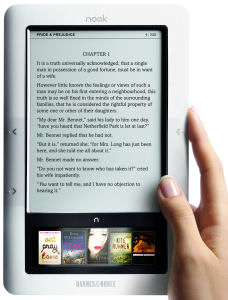 - The
- The  - The
- The 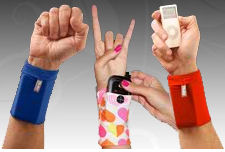 But it's the ingenuity and persistence of these individuals that's really fun to see in action. For example, South Mill Design, a small company based near Princeton, N.J., has developed a wrist pouch called
But it's the ingenuity and persistence of these individuals that's really fun to see in action. For example, South Mill Design, a small company based near Princeton, N.J., has developed a wrist pouch called  The iPad a beautiful device that seems to be quite smooth and responsive, with a 9.7 inch 1024 x 768 multi-touch display (vs. 3.5 inch 480 x 320 for the iPhone), though there is a rather wide bezel around the display.
The iPad a beautiful device that seems to be quite smooth and responsive, with a 9.7 inch 1024 x 768 multi-touch display (vs. 3.5 inch 480 x 320 for the iPhone), though there is a rather wide bezel around the display.  Apple has updated the
Apple has updated the  Even an apparently straightforward app like
Even an apparently straightforward app like 
 Microsoft has lowered the price for its
Microsoft has lowered the price for its 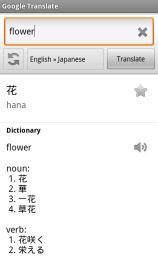
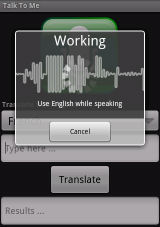
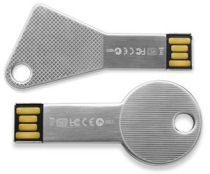
 Even better, you can use the
Even better, you can use the 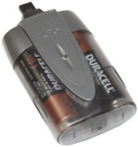 But if you're on an extended trip, and may not be able to plug in to a wall outlet for a while to charge up again, then check out the
But if you're on an extended trip, and may not be able to plug in to a wall outlet for a while to charge up again, then check out the  The
The 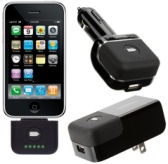 The PowerDuo Reserve product includes three products for complete charging support. It starts with both an AC wall charger and an auto charger for USB-rechargeable devices, including the iPod, iPhone, and other phones and MP3 players. Plus, the chargers are designed with a removable iPod / iPhone battery pack that you can take along when you're uncabled.
The PowerDuo Reserve product includes three products for complete charging support. It starts with both an AC wall charger and an auto charger for USB-rechargeable devices, including the iPod, iPhone, and other phones and MP3 players. Plus, the chargers are designed with a removable iPod / iPhone battery pack that you can take along when you're uncabled.  Apple also has released the
Apple also has released the  Apple has set up the E-books so they are actually are only accessible from the iPad -- You need to download the free
Apple has set up the E-books so they are actually are only accessible from the iPad -- You need to download the free  In particular,
In particular, 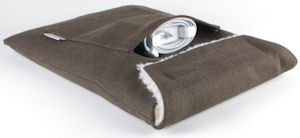 The ColcaSac sleeves are simple and strong, padded with a soft polyester sherpa fleece lining, with a velcro closure, plus a CD-sized external pocket. They are priced at $39.95 with burlap, hemp, or print fabric exteriors, in brown, black, red, and patterns. These are available in a range of sizes for the 13" to 17" MacBook / Pro, MacBook Air, PowerBook, iBook, or other similarly-sized notebooks.
The ColcaSac sleeves are simple and strong, padded with a soft polyester sherpa fleece lining, with a velcro closure, plus a CD-sized external pocket. They are priced at $39.95 with burlap, hemp, or print fabric exteriors, in brown, black, red, and patterns. These are available in a range of sizes for the 13" to 17" MacBook / Pro, MacBook Air, PowerBook, iBook, or other similarly-sized notebooks.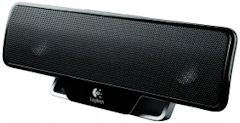 But for more focused sound from your notebook, the
But for more focused sound from your notebook, the 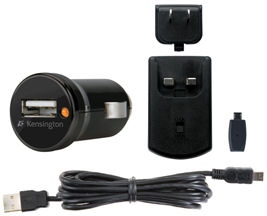 For example, the precisely named
For example, the precisely named 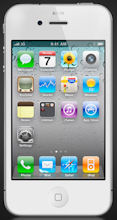 It's June, and time for the next generation
It's June, and time for the next generation  But the iPhone is more than features and functions, as expected from Apple it's also an impressive piece of design -- not just the look and interface, but the industrial design to squeeze more magic into an even smaller form. Apple started by squeezing the thickness by 20 percent, from 0.48 to 0.37 in. (compared to 0.47 in. for the Droid Incredible or 0.33 in. for the iPod touch). The other dimensions and weight remain the same.
But the iPhone is more than features and functions, as expected from Apple it's also an impressive piece of design -- not just the look and interface, but the industrial design to squeeze more magic into an even smaller form. Apple started by squeezing the thickness by 20 percent, from 0.48 to 0.37 in. (compared to 0.47 in. for the Droid Incredible or 0.33 in. for the iPod touch). The other dimensions and weight remain the same. For example, the
For example, the  Then for charging up your collection of devices, the
Then for charging up your collection of devices, the  Case in point: the
Case in point: the  Instead, try out the
Instead, try out the 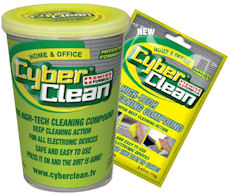 Enter
Enter  Then the recent
Then the recent 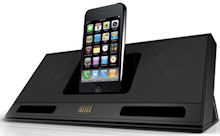 For example, the
For example, the 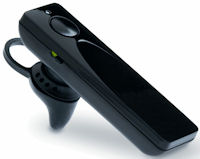 So check out the new
So check out the new  In particular, the
In particular, the  Meanwhile, the tiny clip-on
Meanwhile, the tiny clip-on  Limiting the shuffle's capcity fits in to the biggest change in the iPod line-up -- repositioning the
Limiting the shuffle's capcity fits in to the biggest change in the iPod line-up -- repositioning the 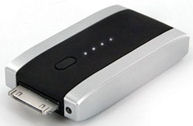 The
The  But there's a different problem if you tend to leave your USB drive plugged in to your computer -- it sticks out the side, getting in the way and susceptible to damage. So the
But there's a different problem if you tend to leave your USB drive plugged in to your computer -- it sticks out the side, getting in the way and susceptible to damage. So the  The
The  The classics never go out of style, so Native Union has introduced the
The classics never go out of style, so Native Union has introduced the  The
The  For a peek at the promise of USB 3.0, I was able to try out the
For a peek at the promise of USB 3.0, I was able to try out the  I'll be speaking tomorrow, Wed., Oct. 20, to the
I'll be speaking tomorrow, Wed., Oct. 20, to the  The CEA also produces the
The CEA also produces the  I've been having fun with the
I've been having fun with the  And for the hot gifts of this holiday season (see
And for the hot gifts of this holiday season (see  For example, there's the
For example, there's the 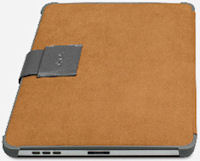 My favorite is the
My favorite is the 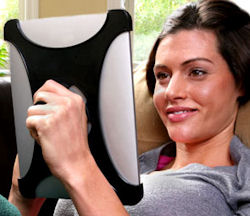 The FreeOneHand changes this completely. It clips onto the four corners of the iPad, with a two-inch pedestal in the back for holding the iPad comfortably with just one hand. For example, you can grip the post securely in your fist, or cup it in your palm in your lap, or hold it between your split fingers.
The FreeOneHand changes this completely. It clips onto the four corners of the iPad, with a two-inch pedestal in the back for holding the iPad comfortably with just one hand. For example, you can grip the post securely in your fist, or cup it in your palm in your lap, or hold it between your split fingers.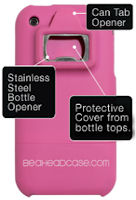 In honor of that big game this weekend, it's time to move on from sensible and fun iPad cases (see
In honor of that big game this weekend, it's time to move on from sensible and fun iPad cases (see 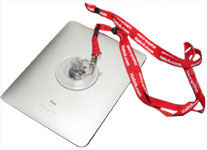 There's the iTatch for iPhones/iPods for $9.95, with a roughly 20-inch lanyard and 1-inch suction cup for smaller handheld devices.
There's the iTatch for iPhones/iPods for $9.95, with a roughly 20-inch lanyard and 1-inch suction cup for smaller handheld devices.  The TabGip is basically four arms of flexible rubberized plastic with grips that snap onto the middle of each side of the iPad.
The TabGip is basically four arms of flexible rubberized plastic with grips that snap onto the middle of each side of the iPad.  So Speck (see
So Speck (see  But instead of clipping it on, you can strap the nano on with the
But instead of clipping it on, you can strap the nano on with the  The Yogi starts with a protective polycarbonate case with rubber bumper edges that snaps on the back of your iPad to protect it from shocks and falls.
The Yogi starts with a protective polycarbonate case with rubber bumper edges that snaps on the back of your iPad to protect it from shocks and falls.  You start by snapping the iPad into the Ori's plastic frame with rubberized protective edges. The back is mounted on hinged cover made of a light silver aluminum / polypropylene composite that fold ups around the iPad as a folio for travel.
You start by snapping the iPad into the Ori's plastic frame with rubberized protective edges. The back is mounted on hinged cover made of a light silver aluminum / polypropylene composite that fold ups around the iPad as a folio for travel.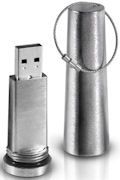 But for even more physical security for your important files, there's the
But for even more physical security for your important files, there's the 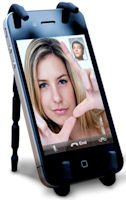 The
The 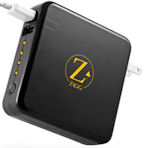 So we'll be seeing more devices like the recently-reintroduced
So we'll be seeing more devices like the recently-reintroduced  The ERA has a clean, compact design, with the trademark Jawbone budge for the voice activity sensor that rests against your cheek, plus a dedicated power switch and standard microUSB port for charging.
The ERA has a clean, compact design, with the trademark Jawbone budge for the voice activity sensor that rests against your cheek, plus a dedicated power switch and standard microUSB port for charging.
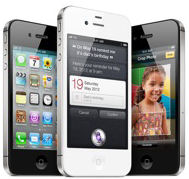 Apple positions the iPhone 4S as the same thin glass and stainless steel design, but "entirely new" on the inside. That's not quite "insanely great," but the 4S actually is yet another impressive piece of engineering from Apple, cramming significant enhancements into the same, still-sweet design as the iPhone 4:
Apple positions the iPhone 4S as the same thin glass and stainless steel design, but "entirely new" on the inside. That's not quite "insanely great," but the 4S actually is yet another impressive piece of engineering from Apple, cramming significant enhancements into the same, still-sweet design as the iPhone 4: And the iPhone 4S also supports the new
And the iPhone 4S also supports the new 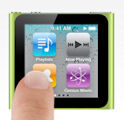 The
The 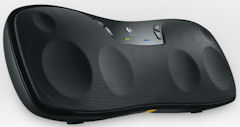 Separate powered speakers also let you crank up the sound to better fill a room, so Logitech has cranked out the new
Separate powered speakers also let you crank up the sound to better fill a room, so Logitech has cranked out the new  But sometime you need something more portable, like the
But sometime you need something more portable, like the 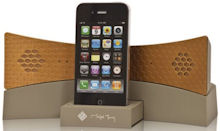 The
The 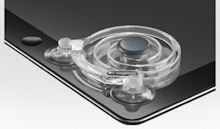 I cover a lot of high-tech gadgets, but here's a simple little accessory -- that even technically qualifies as wireless -- the
I cover a lot of high-tech gadgets, but here's a simple little accessory -- that even technically qualifies as wireless -- the  So if you'd like to try out the touch experience, see the
So if you'd like to try out the touch experience, see the  And now Kindle owners can "borrow" one book for free each month from over 5,000 titles, including more than 100 current and former New York Times Bestsellers.
And now Kindle owners can "borrow" one book for free each month from over 5,000 titles, including more than 100 current and former New York Times Bestsellers. 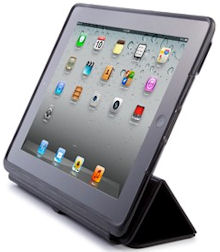 The
The  The
The 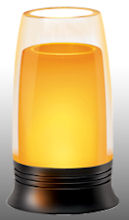 Or LEDs can be dimmer and flickering, as in the new
Or LEDs can be dimmer and flickering, as in the new 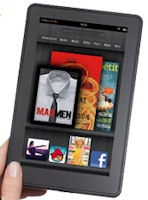 It's clear that portability dominates in the CEA study, as the #1 product that adults would like to receive is tablets (14%), followed by notebooks (11%).
It's clear that portability dominates in the CEA study, as the #1 product that adults would like to receive is tablets (14%), followed by notebooks (11%). 
 For example, the
For example, the 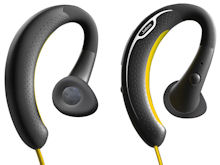 Instead, check out the
Instead, check out the  For example, the
For example, the  There are nice microfiber cloths for cleaning lenses, but the
There are nice microfiber cloths for cleaning lenses, but the 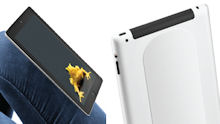 In this case, the simple answer is the new
In this case, the simple answer is the new  Or you can use just one cable, the
Or you can use just one cable, the  You may think of USB cables as functional and not fashion, but the
You may think of USB cables as functional and not fashion, but the  But the
But the  This is what the
This is what the 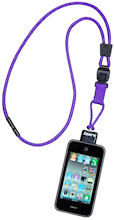 The
The 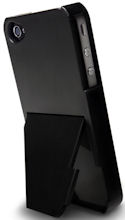 This is the simple design idea behind the
This is the simple design idea behind the 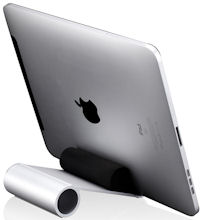 The
The 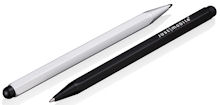 So Just Mobile has another interesting and elegant design idea to offer (see
So Just Mobile has another interesting and elegant design idea to offer (see 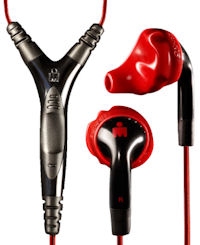
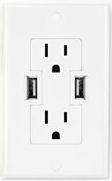 This is the head-smacking sensibleness of the
This is the head-smacking sensibleness of the  But the newly-updated
But the newly-updated  These are resealable element-proof storage bags with a patented leakproof / airtight seal. The hermetic seal keeps out water, air, dust and humidity -- so the bags are certified waterproof to 60 meters / 200 feet.
These are resealable element-proof storage bags with a patented leakproof / airtight seal. The hermetic seal keeps out water, air, dust and humidity -- so the bags are certified waterproof to 60 meters / 200 feet. To meet this need, and more, Mophie has extended its line of portable batteries with the new
To meet this need, and more, Mophie has extended its line of portable batteries with the new 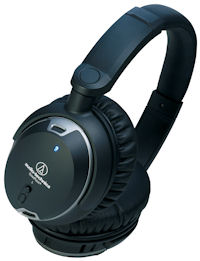
 The
The 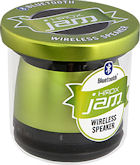 Plus it's cute -- The jam theme is carried by the tapered cylindrical design, and by the packaging -- a plastic jam jar with screw-on lid.
Plus it's cute -- The jam theme is carried by the tapered cylindrical design, and by the packaging -- a plastic jam jar with screw-on lid.  For example, the basic
For example, the basic  In comparison, the higher-end
In comparison, the higher-end 

 The new
The new  The
The  The new iPod touch (generation 5) basically catches up with the previous-generation iPhones and iPads, with the bonus of a 4-inch widescreen Retina display (same res as the iPhone 5, up from 3.5").
The new iPod touch (generation 5) basically catches up with the previous-generation iPhones and iPads, with the bonus of a 4-inch widescreen Retina display (same res as the iPhone 5, up from 3.5"). The original nanos from 2005 and 2006 were click-wheel music players, with a simple 1.5 inch display for choosing music, plus built-in games, calendar, contacts, and notes.
The original nanos from 2005 and 2006 were click-wheel music players, with a simple 1.5 inch display for choosing music, plus built-in games, calendar, contacts, and notes.  With the nano generation 3 in 2007, Apple upgraded the nano to a full-fledged video player with a 2 inch color display with the same resolution as the iPod video. It also provided more advanced interface features like Cover Flow to flip through album covers.
With the nano generation 3 in 2007, Apple upgraded the nano to a full-fledged video player with a 2 inch color display with the same resolution as the iPod video. It also provided more advanced interface features like Cover Flow to flip through album covers. 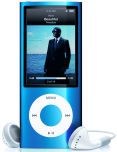 Then the nano gen 5 from 2009 kept the same design, but stepped back up even closer to iPhone/touch kind of capabilities as an almost-but-not-quite iOS device, keeping the narrow design but adding a slightly larger 2.2 inch display plus a video camera, microphone and speaker, FM radio, and pedometer.
Then the nano gen 5 from 2009 kept the same design, but stepped back up even closer to iPhone/touch kind of capabilities as an almost-but-not-quite iOS device, keeping the narrow design but adding a slightly larger 2.2 inch display plus a video camera, microphone and speaker, FM radio, and pedometer.  Which brings us to last week's announcement of the iPod nano generation 7, which jumps back into the widescreen media player world, following the example of the new iPod touch and iPhone 5 -- but with a custom interface still separate from the iOS world
Which brings us to last week's announcement of the iPod nano generation 7, which jumps back into the widescreen media player world, following the example of the new iPod touch and iPhone 5 -- but with a custom interface still separate from the iOS world The smaller Big Blue Live is mini enough to pack for trips (~ 5 x 2 1/2 x 2 1/3 in. and 1.4 lbs.), but large enough to pack stereo speakers for a strong sound, plus a down-firing passive radiator for bass, with a total of 4 W.
The smaller Big Blue Live is mini enough to pack for trips (~ 5 x 2 1/2 x 2 1/3 in. and 1.4 lbs.), but large enough to pack stereo speakers for a strong sound, plus a down-firing passive radiator for bass, with a total of 4 W. 
 The Matrix one is a 3.5 watt Bluetooth speaker that adds a mic to also work as a speakerphone.
The Matrix one is a 3.5 watt Bluetooth speaker that adds a mic to also work as a speakerphone. 
 But for a more immersive experience, you need to split the scene into a pair of separate views for each eye, and use lenses to focus them properly for viewing.
But for a more immersive experience, you need to split the scene into a pair of separate views for each eye, and use lenses to focus them properly for viewing. 
 Or the
Or the 
 And while Fitbit has a large and evolving line of sexy wearable wristbands and watches, it also has two other simpler "pocket trackers" -- the
And while Fitbit has a large and evolving line of sexy wearable wristbands and watches, it also has two other simpler "pocket trackers" -- the 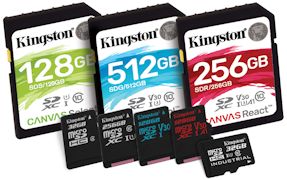 Kingston SD and microSD cards
Kingston SD and microSD cards  Otherwise, you can use a card reader like the
Otherwise, you can use a card reader like the  But USB 3.0 is so old hat -- USB Type C is the new, better connector that is now being used on both laptops and on portable devices including smartphones and tablets.
But USB 3.0 is so old hat -- USB Type C is the new, better connector that is now being used on both laptops and on portable devices including smartphones and tablets.  The
The  Similarly, the
Similarly, the  You can start with the
You can start with the  Then the
Then the 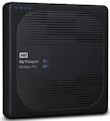 The
The  The
The  For example, the
For example, the  Another option is a combination desktop charging stand and backup battery like the
Another option is a combination desktop charging stand and backup battery like the  Ventev also offers the
Ventev also offers the  For personal use, at your desk or in a hotel room, you can start with a mini speaker like the
For personal use, at your desk or in a hotel room, you can start with a mini speaker like the  Or step up to a slightly larger speaker like the
Or step up to a slightly larger speaker like the 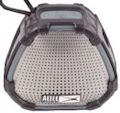 Then the Altec Lansing Versa line of smart speakers pairs and plays over both Bluetooth (for on the go) and Wi-Fi (for at home). Use the Altec Lansing VersA Navigator app for Wi-Fi setup and to bridge to Amazon Alexa for tap-to-talk voice control.
Then the Altec Lansing Versa line of smart speakers pairs and plays over both Bluetooth (for on the go) and Wi-Fi (for at home). Use the Altec Lansing VersA Navigator app for Wi-Fi setup and to bridge to Amazon Alexa for tap-to-talk voice control.  One nice solution, used with the
One nice solution, used with the 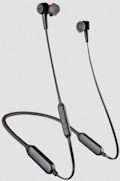 For longer use in earbuds, the
For longer use in earbuds, the  Then, of course, the best way to isolate yourself on a long plane trip is to use over-the ear headphones, like the
Then, of course, the best way to isolate yourself on a long plane trip is to use over-the ear headphones, like the 

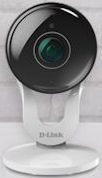
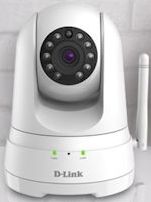
 This second edition of the product includes two key features from pro drones: auto stabilization, so it can hover in place automatically without you needing to constantly tweak the controls, and auto tracking, so it can lock in on your face and keep you in the view even as you move.
This second edition of the product includes two key features from pro drones: auto stabilization, so it can hover in place automatically without you needing to constantly tweak the controls, and auto tracking, so it can lock in on your face and keep you in the view even as you move.